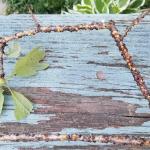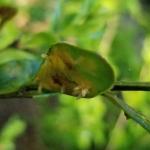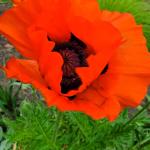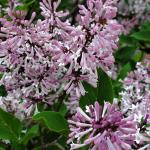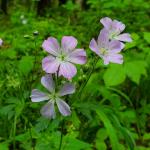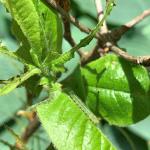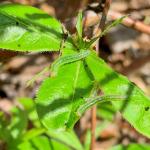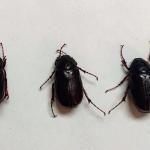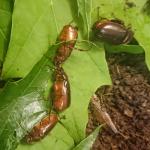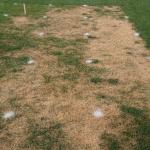UMass Extension's Landscape Message is an educational newsletter intended to inform and guide Massachusetts Green Industry professionals in the management of our collective landscape. Detailed reports from scouts and Extension specialists on growing conditions, pest activity, and cultural practices for the management of woody ornamentals, trees, and turf are regular features. The following issue has been updated to provide timely management information and the latest regional news and environmental data.
UMass Extension has developed a listing of resources for commercial horticulture operations in Massachusetts to help keep you informed and aware of relevant policies and best practices for landscapers, turf managers, arborists, nurseries, garden centers, and greenhouse producers.
For our COVID-19 Information and Support for Landscapers, Nurseries, Turf Managers, Garden Centers, Arborists, and Greenhouse Operations in Massachusetts, go to https://ag.umass.edu/landscape/news/covid-19-information-support-for-landscapers-nurseries-turf-managers-garden-centers.
The Landscape Message will be updated weekly in June. The next message will be posted on June 12. To receive immediate notification when the next Landscape Message update is posted, be sure to join our e-mail list.
To read individual sections of the message, click on the section headings below to expand the content:
Scouting Information by Region
Environmental Data
The following data was collected on or about June 3, 2020. Total accumulated growing degree days (GDD) represent the heating units above a 50° F baseline temperature collected via our instruments for the 2020 calendar year. This information is intended for use as a guide for monitoring the developmental stages of pests in your location and planning management strategies accordingly.
|
MA Region/Location |
GDD |
Soil Temp |
Precipitation
|
Time/Date of Readings |
||
|
1-Week Gain |
2020 Total |
Sun |
Shade |
|||
|
CAPE |
89.5 |
224 |
63 |
59 |
0.28 |
12:00 PM 6/3 |
|
SOUTHEAST |
96.5 |
267 |
74 |
64 |
0.03 |
3:30 PM 6/3 |
|
NORTH SHORE |
98 |
284.5 |
60 |
56 |
0.10 |
4:00 PM 6/3 |
|
EAST |
103.5 |
325 |
68 |
63 |
0.11 |
5:00 PM 6/3 |
|
METRO |
108 |
299.5 |
59 |
55 |
0.09 |
6:45 AM 6/3 |
|
CENTRAL |
90.5 |
289.5 |
60 |
58 |
0.03 |
12:00 PM 6/3 |
|
PIONEER VALLEY |
92.5 |
302.5 |
69 |
56 |
0.06 |
5:00 PM 6/3 |
|
BERKSHIRES |
80.5 |
272.5 |
60 |
56 |
0.06 |
8:00 AM 6/3 |
|
AVERAGE |
95 |
283 |
64 |
58 |
0.04 |
_ |
|
n/a = information not available |
||||||
Using data from 6/2, this map of MA shows "Abnormally Dry" (D0) conditions present in all of Essex County, most of Middlesex County, the northern three-quarters of Worcester County and the eastern thirds of both Franklin and Hampshire Counties: https://droughtmonitor.unl.edu/CurrentMap/StateDroughtMonitor.aspx?MA
Phenology
| Indicator Plants - Stages of Flowering (BEGIN, BEGIN/FULL, FULL, FULL/END, END) | ||||||||
|---|---|---|---|---|---|---|---|---|
|
PLANT |
CAPE |
SE |
NS |
EAST |
METRO |
CENT |
PV |
BERK |
|
Syringa meyeri (Meyer lilac) |
* |
* |
* |
Begin |
* |
* |
Begin/Full |
Begin |
|
Robinia pseudoacacia (black locust) |
* |
Full |
* |
Full |
* |
Begin |
Begin/Full |
* |
|
Deutzia spp. (Deutzia species) |
Begin/Full |
Full |
* |
Full |
* |
Begin |
Begin |
Begin |
|
Weigela florida (old fashioned Weigela) |
Begin/Full |
Full |
Full |
Full |
Full |
Full |
Full |
Begin |
|
Aesculus hippocastanum (common horsechestnut) |
Full |
Full |
Full |
Full |
Full |
Full |
Full |
Full |
|
Enkianthus campanulatus (redvein Enkianthus) |
* |
* |
* |
Begin |
Full |
Full |
Full |
Full |
|
Rhododendron carolinianum (Carolina Rhododendron) |
Full/End |
* |
Full |
Full |
Full |
Full |
Full |
Full |
|
Rhododendron catawbiense (Catawba Rhododendron) |
Full |
Full/End |
Full |
Full |
Full |
Full |
Full |
Full |
|
Spiraea x vanhouttei (Vanhoutte Spirea) |
Full/End |
* |
Full |
Full/End |
Full/End |
Full |
Full/End |
Full |
| * = no activity to report/information not available | ||||||||
Regional Notes
Cape Cod Region (Barnstable)
General Conditions: The average temperature over the period was 62˚F with a high of 76˚F on May 28 and a low of 47˚F on June 2nd. Overall, the period was sunny and comfortable, except for May 29 which had light showers and high relative humidity. Just over a quarter inch of precipitation fell during the period leaving topsoil moisture short; subsoil moisture remains adequate. Lawns without irrigation are already showing signs of water stress. Newly planted trees, shrubs, perennials and annuals need to be watered frequently. Tree pollen from oak and pine was abundant enough to cover everything in yellow this past week and wreak havoc on those with allergies.
Pests/Problems: Lecanium scale females have grown into their distinctive hemispherical shape, making them much easier to see and recognize on woody twigs. Copious amounts of honeydew are being produced under heavily infested trees. Some white oaks with heavy populations are showing branch and twig dieback. A couple of small areas of defoliation on oak, maple and beech from winter moth and cankerworm have been seen in the upper Cape. In other areas winter moth damage is becoming more apparent, though not causing defoliation but the typical swiss cheese looking leaves. Winter moth caterpillars are nearing the end of feeding and beginning the process of migrating to the ground to pupate. Other insect pests or damage seen over the period include black turpentine beetle fresh pitch tubes on pitch pine, Viburnum leaf beetle on arrowwood Viburnum, rose slug sawfly larvae on rose, dogwood sawfly larvae on alternate leaf dogwood, boxwood psyllid on boxwood, boxwood leafminer emergence on boxwood, Hydrangea leaf-tier on smooth Hydrangea, elder shoot borer moth on elderberry, galls (cynipid wasp) on Rosa rugosa, and Andromeda lacebug damage on Andromeda.Disease symptoms or signs observed over the period include sycamore anthracnose, maple anthracnose, holly leaf spot, leaf spot on azalea, leaf spot on mountain laurel (Phyllosticta), Exobasidium gall on Rhododendron, black spot on rose and red thread on turf. Weeds in bloom include black medic (Medicago lupulina), cypress spurge (Euphorbia cyparissias), chickweed (Stellaria media), white clover (Trifolium repens), creeping buttercup (Ranunculus repens) and cinquefoil (Potentilla simplex). Other pests or pest damage seen include slugs on Hosta, rabbits on annuals and lots of dog ticks.
Southeast Region (Dighton)
General Conditions: We've had another disappointing week with regard to rainfall. Most days have required a light jacket in the morning. Otherwise, this is New England at its best in scope and variety of plant and wildlife. The hedges are full of squabbling birds with chicks to feed and paper wasp nests are 2-3 cm wide. Carpenter bee males are vigorously patrolling their territories dispensing eye level challenges to stray humans. It's very hard to keep up with the number of emergent plants. Among those in flower now are: Cytisus scoparius (Scotch broom), Laburnum anagyroides (golden rain, golden chain tree), Euonymus altissima (winged Euonymus, burning bush), Iris geranium (German Iris), I. sibirica (Siberian Iris), Digitalis purpurea (biennial foxglove), Robinia pseudoacacia (black locust), Cerastium tomentosum (snow-in-summer), Potentilla spp. (cinquefoil), Prunus serotina (black cherry), P. laurocerasus (cherry laurel), Papaver orientale (Oriental poppy), Allium spp. (ornamental onion), Aquilegia spp. (columbine), Nepeta faassenii (catmint), Achillea millefolium 'Moonglow' (yarrow), Rosa rugosa (beach rose), R. hybrid 'Knockout', Tradescantia spp. (spiderwort), Cornus kousa (Chinese dogwood), Cornus sericea (redosier dogwood), Deutzia spp, Viburnum plicatum (Japanese snowball), V. plicatum var. tomentosum (double-file Viburnum), V. dentatum (arrowwood), Hieracium spp. (hawkweed), Chelidonium majus (greater celandine), Trifolium reptans (white clover), Hesperis matronalis (dame's rocket), Chionanthus virginicus (American fringetree), Dicentra formosa (Pacific bleeding-heart), Paeonia officinalis (common peony), Oxalis stricta (wood sorrel), Polygonatum biflorum (Solomon's seal), Geranium maculatum (wild geranium), Dianthus deltoides (maiden pinks), Ranunculus repens (creeping buttercup), Clematis spp. (large flowered hybrids), Lamprocapnos spectabilis (bleeding heart), Lupinus spp. (lupine), Vaccinium corymbosum (highbush blueberry), Rhododendron spp.(Rhododendrons, azaleas), Rubus spp. (brambles), Glechoma hederacea (ground ivy), Salvia nemorosa (garden Salvia), Silene latifolia (white campion), Baptisia australis (bluebell), Myosotis scorpioides (forget-me-not), Leymus mollis (dune grass), Rumex acetosella (sheep sorrel), Aesculus hippocastanum (horsechestnut), Lonicera maackii (Amur honeysuckle), Elaeagnus umbellata (autumn olive), Spirea spp. (bridal wreath), Convallaria majalis (lily-of-the-valley) and prostrate Sedum.
Pests/Problems: Weevils were observed making profuse and perfectly round 3 mm holes in R. rugosa (beach rose) petals. Hedge bindweed is now approximately three feet long and this is your last chance before it overtakes the garden and hedgerow entirely. Everything needs more water.
North Shore (Beverly)
General Conditions: The last days of May were warm and dry with the highest temperature of 81℉ recorded on May 29. The first week of June has been mild with an average temperature of around 60℉. The highest temperature recorded in this first week was 77℉ on June 3. The minimum temperature during this period was 42℉ recorded on June 2. The general condition during this reporting period was sunny and dry. Soils are lacking moisture and grass on lawns that are exposed to full sun are turning brown due to water stress. Only about 0.10 inches of rain were received during this reporting period at Long Hill in Beverly. Some woody plants observed in bloom include: horse chestnut (Aesculus hippocastanum), dove tree (Davidia involucrata), common lilac (Syringa vulgaris), Korean lilac (Syringa pubescens), Wisteria (Wisteria floribunda), silver bell (Halesia carolina), golden chain tree (Laburnum anagyroides), redbud (Cercis canadensis), mountain laurel (Kalmia latifolia), several azaleas and Rhododendrons (Rhododendron spp.) and tree peony (Paeonia suffruticosa). Herbaceous plants in bloom include: garden peony (Paeonia lactiflora), Japanese primrose (Primula japonica), Allium (Allium spp.) and fetterbush (Leucothoe fontanesiana).
Pests/Problems: Galls of azalea leaf and flower gall (Exobasidium vaccinii) are starting to develop the white spore layer. Prune them off immediately and discard them in the trash. Viburnum leaf beetles have almost completely skeletonized the leaves of American cranberrybush Viburnum which is susceptible. Arrowwood Viburnum is also susceptible. Aphids were observed on black lace elderberry (Sambucus nigra) and rose slug sawfly larvae were observed causing serious damage on some rose bushes. Weeds seen in bloom include: sweet woodruff (Galium odoratum) and violets (Viola spp.). Mosquitoes and ticks are very active - protect yourself with repellents when working outdoors!
East Region (Boston)
General Conditions: Over the last two weeks, low temperatures ranged from 41°F to 68°F, averaging 55°F and high temperatures have ranged from 66°F to 86°F, averaging 76°F. We have gained 103.5 GGDs over the same period bringing the total to 325 for the year. This region received only 0.11 inches of precipitation this week. Supplemental irrigation is necessary. For the month of May, temperatures ranged from 33°F to 86°F with an average temperature of 57°F. May has been fairly windy compared to previous years. Plants in bloom include: Aesculus hippocastanum (horsechestnut), Aesculus parviflora (bottlebrush buckeye), Allium (Nectaroscordum) siculum (Sicilian honey garlic), many Clematis cultivars (Clematis), Leucothoe axillaris (coast Leucothoe), Lupinus perennis (wild lupine), Magnolia sieboldii (Korean mountain Magnolia), Rhododendron spp. (Rhododendron), Robinia pseudoacacia (black locust), Sorbus alnifolia (Korean mountain ash), Styrax obassia (fragrant snowbell), Vaccinium corymbosum (northern highbush blueberry), Weigela florida (old fashioned Weigela), and Xanthoceras sorbifolia (yellowhorn).
Pests/Problems: Lack of precipitation is a concern. May ended 1.25” below the historical average for the month and we remain 3” below average for the year. Despite the recent dry conditions, fungal pathogens that spread during the wet spring continue to show up on Amelanchier spp. (shadblow, serviceberry), crabapples and roses in a wide variety of leaf spot diseases. Peach tree leaf curl continues to disfigure the leaves of many ornamental peaches. The primarily aesthetically displeasing issue is the boxwood psyllid (Psylla buxi) - adults can be observed hopping around most boxwood. Another mostly cosmetic concern has been the observance of the Eriophyidae gall mites on many landscape maples. Viburnum leaf beetle (Pyrrhalta viburni) larvae have emerged and are actively defoliating susceptible Viburnum. Lilioceris lilii (scarlet lily beetle) is actively defoliating susceptible lilies.
Metro West (Acton)
General Conditions: Summer-like temperatures continued into the beginning days of this reporting period but thankfully did not last. There were four days with temperatures recorded in the 80’s. A high temperature of 88°F was recorded on the 27th, subsequently followed by readings of 83°, 84° and 81°. As the month of May came to a close, this area did not reach the monthly average precipitation of 4.04”. The total rainfall recorded for the month was only 1.91”. The monthly average precipitation for June is 3.93” and we are at 0.09” as of the 3rd. Despite the lack of rain, the landscape is surprisingly lush! The landscape is green and filled with color. Observed in some stage of bloom this past week were the following woody plants: Aesculus x carnea (red horsechestnut), A. hippocastanum (horsechestnut), Calycanthus floridus (Carolina allspice), Chionanthus retusus (Chinese fringetree), C. virginicus (American fringetree), Cornus florida (dogwood), C. x rutgersensis 'Ruth Ellen' (Rutgers hybrid dogwood), Cornus sericea (redosier/red twig dogwood), Cotinus coggygria (smoketree), Leucothoe axillaris (coast Leucothoe), Lonicera maackii (Amur honeysuckle), Prunus serotina (black cherry), Rhododendron spp. (Rhododendron and azalea), Rosa rugosa (beach rose), Rubus spp. (bramble, blackberry), Spiraea spp. (bridal wreath), Syringa spp. (lilac), Viburnum plicatum var. tomentosum (doublefile Viburnum), V. sargentii (Sargent Viburnum), and Weigela florida (old fashioned Weigela).
Woody vines observed in bloom were: Aristolochia macrophylla (dutchman’s pipe), Lonicera sempirvirens (trumpet honeysuckle), and Wisteria spp. (Wisteria). Contributing even more color and interest to the landscape are some flowering herbaceous plants and spring ephemerals including: Ajuga reptans (bugleweed), Alchemilla mollis (lady’s mantle), Allium spp. (ornamental flowering onion) including A. schoenoprasum (chives), Aquilegia canadensis (columbine), Aquilegia spp. (columbine), Amsonia hubrichtii (Arkansas blue star), Baptisia australis (false blue indigo), Brunnera macrophylla (alkanet), Chrysogonum virginianum (green and gold), Convallaria majalis (lily of the valley), Dianthus deltoides (maiden pink), Dictamnus albus (gas plant), Dicentra eximia (fringed bleeding heart), D. spectabilis (old fashioned bleeding heart), D. spectabilis ‘Alba’ (white old fashioned bleeding heart), Dodecatheon meadia (shooting star), Gallium odoratum (sweet woodruff), Geranium maculatum (wild Geranium), G. macrorrhizum (bigroot Geranium), G. sanguineum (cranesbill Geranium), Hemerocallis spp. (early flowering daylily), Hyacinthoides hispanica (wood Hyacinth), Iris germanica (bearded Iris), I. sibirica (Siberian Iris), Lupinus 'Russell Woodfield Hybrids' (lupine), Myosotis sylvatica (forget-me-not), Nepeta spp. (ornamental catmint), Paeonia spp. (peony), Phlox divaricata (Canadian Phlox), P. stolonifera (creeping Phlox), P. x subulata (moss Phlox), Polygonatum commutatum (great Solomon’s seal), P. odoratum 'Variegatum' (variegated Solomon’s seal), Potentilla tridentata (three leaf cinquefoil), Primula spp. (primrose), Salvia nemorosum (Salvia), Saponaria ocymoides (rock soapwort), Stylophorum diphyllum (wood/celandine poppy), Thymus praecox (thyme), Tiarella cordifolia (foam flower), Veronica umbrosa ‘Georgia Blue’ (speedwell), and Zizia aptera (heart-leaved Alexanders).
Pests/Problems: Soils are dry without any significant rain recorded in the past few weeks. With only a mere 0.09” recorded during this reporting period and less than that reported in the previous week’s report, it is well worth monitoring trees and shrubs for early signs of drought stress.
Central Region (Boylston)
General Conditions: It was another warm week, although much more comfortable than the last. Daytime temperatures were consistently seasonable, while overnight temperatures were dangerously low at this time of year, touching the mid-30’s at least one evening. The common refrain in the garden has increasingly become “I wish it would rain.” Less than half an inch of precipitation was recorded this week, marking three reporting periods with no appreciable rainfall and none in sight for the upcoming week. Soils are dry and powdery, not a welcome condition at the height of spring. Despite the dry conditions, the garden is awash with color. Notable blooms this period include Achillea ‘Moonshine’ (yarrow), Geranium maculatum (wild Geranium), Maianthemum canadense (Canada mayflower), Maianthemum racemosum (false Solomon’s seal), Calycanthus floridus (Carolina allspice), Diphylleia cymosa (umbrella leaf), Chamaepericlymenum canadense (formerly Cornus canadensis) – (bunchberry), Rubus occidentalis (black raspberry), Papaver orientale (Oriental poppy), and numerous Rhododendrons, azaleas, lilacs, and Viburnums.
Pests/Problems: The biggest issue gardeners are faced with at the moment is drought conditions. Newly planted trees, shrubs, perennials, annuals, and vegetables need consistent moisture to become established in the garden. Without adequate rainfall, gardeners will need to spend more time watering, leaving less time for all of the other time sensitive garden tasks in spring. Drought periods will ultimately lead to plant stress, even on established plants in the garden. We should all be hoping the pattern changes and we begin to see additional rainfall in the near future. Birch sawfly was observed this week.
Pioneer Valley Region (Easthampton)
General Conditions: June has arrived and the landscape is thriving with new growth and color. Rhododendrons and azaleas are really looking great this year, in contrast to last year when many suffered serious winter-related injuries. Warm and humid conditions persisted in the Pioneer Valley from Tuesday, 5/26 into the early morning hours of Saturday, 5/30. Dew points over this humid stretch were mostly in the low to mid-60s but peaked in the low 70s on Friday, 5/29. A cold front swept through the region during the evening hours of 5/29, but the storms dissipated over the Berkshires and the valley was left with just trace amounts of rainfall. Winds were also gusty from 5/29 into 5/31 as the humid air mass cleared out. By Sunday 5/31, temperatures peaked only in the mid-60s and overnight lows into June 1 dropped to the upper 30s. The low temperature during the morning on Friday, 5/29 (68°F) was more than 30°F warmer than the low on Monday, 6/1 (37°F). The first few days of June have been beautiful, with a mixture of sun and clouds, high temperatures in the upper 60s to low 70s and lows in the mid-50s. However, at the time of writing another warm and humid stretch is building, with temperatures forecast to hit 90°F by Friday, 6/5. But once again, thunderstorms should clear out the heat and temperatures will moderate by Sunday, 6/7. Since 5/1, there has been less than 1ʺ of precipitation at many weather stations in the tri-county area. Soils are really drying out in sunny, exposed landscapes as plants are drawing up moisture for new growth and transpiration. The late May hot stretch did little to slow down turfgrasses under irrigation or in shade, which continue to grow at a strong rate. Unirrigated lawns in full sun are starting to brown and wilting clover has been observed. According to the U.S. Drought Monitor (https://droughtmonitor.unl.edu/CurrentMap/StateDroughtMonitor.aspx?MA) abnormally dry conditions (D0) have now been classified in eastern Franklin and Hampshire Counties. Crabgrass is starting to take off but the cool temperatures at the start of the month have stunted growth somewhat. Pollen is still very abundant, coating surfaces outdoor and in, if the windows are left open.
Pests/Problems: Drought stress is not a major concern as of yet for established trees and shrubs. However, perennials, annuals and recently transplanted trees and shrubs could be experiencing drought stress if supplemental irrigation is not provided. Continue to provide a soaking irrigation of the roots for plants in need. Ensure soil is being properly soaked, as mulch can absorb a lot of water, leaving the underlying soil bone dry in some cases. A variety of aphids, mites and wasps are creating leaf galls on deciduous plants like maple, elm, witch hazel and oak. Aphids on flowering honeysuckle (Lonicera ‘Mandarin’) were observed. Mounting aphid populations can destroy the flowering parts on these attractive landscape plants. Minor cases of anthracnose, caused by Apiognomonia errabunda, have been observed on American beech, but overall, anthracnose diseases appear to be minor in this region (based on limited scouting). Apple scab, cedar-apple rust and frog eye leaf spot can all be found on apple and crabapple leaves at this time. An infestation of the European elm scale (Gossyparia spuria) was observed on the main trunk of a DED-resistant American elm (U. americana ‘Valley Forge’). Larvae of the azalea sawfly (either Amauronematus azaleae or Nematus lipvskyi) were found defoliating several deciduous azaleas (Rhododendron ‘Gibraltar’) in the landscape (see photos below). Leaves can be stripped down the midrib, causing serious damage when outbreaks go undetected. The caterpillars are camouflaged very well against the foliage but the defoliation is very conspicuous. Evergreen azaleas and Rhododendrons do not serve as hosts of this insect pest. Deer, rabbits, voles and chipmunks are active in localized areas of the landscape. Black flies continue to be abundant and mosquito populations, while suppressed by the dry weather, are still plentiful in shaded settings and in the forest.
Berkshire Region (Great Barrington)
General Conditions: Wide temperature swings have again been the norm, with a daytime high of 83˚F on May 29 (and a morning low of 68), to a daytime high of 60˚F on May 31 followed by a morning low of 37˚F on June 1. However, it is the lack of precipitation that is the current concern. At present (June 3), rainfall for the year-to-date is 4.34 inches below the normal year-to-date amount. The last significant rainfall occurred on April 13th. Except for May 15 when 0.66 inches fell, no significant rain has fallen since the April date. Nevertheless, growth of established plantings does not yet seem to be affected. Newly planted materials are struggling if no irrigation has occurred. Growth of turfgrass has slowed a little but no significant browning is evident. Poison ivy has spread quite rapidly and many landscape workers have experienced the rash.
Pests/Problems: Pest activity has increased dramatically over the past week. The first spotting of Eastern tent caterpillars occurred but the population and overall infestation has been surprisingly scant. Viburnum leaf beetle larvae are now actively feeding. Wilting of shoots of black lace elderberry were found to be caused by a borer, a common occurrence on this elderberry. Spittlebug was spotted on dwarf willow. Boxwood leaf miner adults are now flying about in very large numbers. Likewise, boxwood psyllid infestations are very high. Other plant pests observed include spruce spider mite, woolly beech aphid, and imported willow leaf beetle larvae. Plant diseases have been few, most likely due to the dry conditions this spring. Currently, only black spot on roses and apple scab have been observed. The most frequent comment heard this spring has been in regard to the very high population of chipmunks. The populations of deer tick adults and wasps (and stings to outdoor workers) remains high.
Regional Scouting Credits
- CAPE COD REGION - Russell Norton, Horticulture and Agriculture Educator with Cape Cod Cooperative Extension, reporting from Barnstable.
- SOUTHEAST REGION - Brian McMahon, Arborist, reporting from the Dighton area.
- NORTH SHORE REGION - Geoffrey Njue, Green Industry Specialist, UMass Extension, reporting from the Long Hill Reservation, Beverly.
- EAST REGION - Kit Ganshaw & Sue Pfeiffer, Horticulturists reporting from the Boston area.
- METRO WEST REGION – Julie Coop, Forester, Massachusetts Department of Conservation & Recreation, reporting from Acton.
- CENTRAL REGION - Mark Richardson, Director of Horticulture reporting from Tower Hill Botanic Garden, Boylston.
- PIONEER VALLEY REGION - Nick Brazee, Plant Pathologist, UMass Extension Plant Diagnostic Lab, temporarily reporting from Easthampton.
- BERKSHIRE REGION - Ron Kujawski, Horticultural Consultant, reporting from Great Barrington.
Woody Ornamentals
Diseases
The UMass Plant Diagnostic Lab remains closed to sample submission at this time. When a reopening date is established, it will be shared widely.
Needle browning and shedding is at or near peak for white pines affected by needle blight. Research has shown that peak needle shedding often corresponds with peak spore dispersal and infection by the various fungal pathogens associated with needle blight. The current season’s needles become infected but will not show symptoms for months. While diseased trees may have stunted shoots and needles, a study from the University of New Hampshire showed that diseased white pines are prioritizing carbon storage over growth, meaning they should have carbon reserves to remain alive. For more information on the pests and pathogens involved, see here: https://ag.umass.edu/landscape/fact-sheets/dieback-of-eastern-white-pine
There have been multiple reports of maple anthracnose, despite the dry weather. Symptoms are appearing as dark-colored, angular lesions on the foliage that are primarily clustered along the leaf veins. For otherwise healthy trees, management is not warranted, especially given the dry and warm conditions at present. Sycamore anthracnose is keeping American sycamore from flushing new growth as well. Despite the dry weather over the past month, inoculum levels could be high in the canopies after the major outbreak many trees experienced in 2019.
Be on the lookout for beech leaf disease (BLD). To date, BLD is present in CT (New Haven and Fairfield Counties) and NY (Westchester, Rockland and Suffolk Counties). Disease outbreaks in the Midwest and the northeast have both originated in coastal areas, suggesting the vector may prefer coastal habitats or the environmental conditions for disease development are more conducive in these areas. Symptoms of infection include dark green, interveinal banding and distorted, crinkled and shriveled leaves. Over time, the leaves die and are prematurely shed from the canopy.
Report by Nick Brazee, Plant Pathologist, UMass Extension Plant Diagnostic Lab, UMass Amherst.
Insects
A New Opportunity for Online Learning about Invasive Insects!
Join UMass Extension’s Landscape, Nursery, and Urban Forestry Program and UMass Extension’s Fruit Program for an exciting FREE series of seven webinars focusing on the impact, monitoring, and management of invasive insects in Massachusetts and the nation! Topics include the spotted lanternfly, spotted wing drosophila, brown marmorated stink bug, emerald ash borer, gypsy moth, Asian longhorned beetle, and more! Webinars will be held from Noon-1:00 PM on May 21, May 28, June 4, June 9, June 16, June 23, and June 30, 2020. Each webinar in this series offers 1 pesticide credit (categories 29, 35, 36, and applicators (core)) and MCA/MCLP’s earn 0.5 education credits for each webinar. ISA and SAF credits are available.
The fourth webinar in this series will happen LIVE on:
Tuesday, June 9, 2020
Green Industry and Homeowner Response to the Spotted Lanternfly in Pennsylvania
Emelie Swackhamer, Horticultural Educator, Penn State Extension
Pennsylvanians are fighting back in ornamental landscapes and production nurseries. Agencies and volunteers have destroyed millions of SLF by scraping eggs and banding trees and large areas of Ailanthus altissima trees have been removed. This session will also address how garden centers and tree care services are providing options for their customers.
Don’t miss this excellent opportunity! For more information about all of the webinars in this series, to register, and to see archived recordings for any that you missed, visit: https://ag.umass.edu/landscape/education-events/invasive-insect-webinars
Insects and Other Arthropods of Public Health Concern:
- Deer Tick/Blacklegged Tick: Check out the archived FREE TickTalk with TickReport webinars available here: https://ag.umass.edu/landscape/education-events/webinars . Previous webinars including information about deer ticks and associated diseases, ticks and personal protection, and updates from the Laboratory of Medical Zoology are archived at the link above.
The next live webinar will be held on June 10, 2020: Tick Management and Control. Dr. Stephen Rich (Professor of Microbiology and Director of the UMass Laboratory of Medical Zoology) and Dr. Kirby Stafford (Chief Scientist at the Connecticut Agricultural Experiment Station and CT State Entomologist) will discuss tick management strategies applicable to landscapes in the Northeast. Dr. Stafford is a medical veterinary entomologist whose research expertise is on the ecology and control of ticks, especially the black-legged or deer tick (Ixodes scapularis) that transmits several pathogens, including those that cause Lyme disease, human babesiosis, and human ehrlichiosis.
Ixodes scapularis nymphs (immatures) are active, and may be encountered at this time, through August. Nymphs will have already taken a blood meal, and therefore can be infected with disease causing pathogens. It is important to protect yourself against ticks and be especially vigilant for tiny, difficult to see nymphs. For images of all deer tick life stages, along with an outline of the diseases they carry, visit: http://www.tickencounter.org/tick_identification/deer_tick .
Anyone working in the yard and garden should be aware that there is the potential to encounter deer ticks. The deer tick or blacklegged tick can transmit Lyme disease, human babesiosis, human anaplasmosis, and other diseases. Preventative activities, such as daily tick checks, wearing appropriate clothing, and permethrin treatments for clothing (according to label instructions) can aid in reducing the risk that a tick will become attached to your body. If a tick cannot attach and feed, it will not transmit disease. For more information about personal protective measures, visit: http://www.tickencounter.org/prevention/protect_yourself .
Have you just removed an attached tick from yourself or a loved one with a pair of tweezers? If so, consider sending the tick to the UMass Laboratory of Medical Zoology to be tested for disease causing pathogens. To submit a tick to be tested, visit: https://www.tickreport.com/ and click on the blue “Order a TickReport” button. Results are typically available within 3 business days, or less. By the time you make an appointment with your physician following the tick attachment, you may have the results back from TickReport to bring to your physician to aid in a conversation about risk.
Due to unprecedented circumstances of the global pandemic, the University of Massachusetts has mandated work furloughs for all university staff. Unfortunately this order comes at the annual peak of tick activity, and hence TickReport testing will not be available during the furlough. Effective at 11:59PM on 3-June-2020, until 12:01AM on 19-June-2020, TickReport will not be accepting new orders. For a full statement from TickReport, please visit: https://www.tickreport.com. Please contact TickReport with further questions and updates on the status of their service.
The UMass Laboratory of Medical Zoology does not give medical advice, nor are the results of their tests diagnostic of human disease. Transmission of a pathogen from the tick to you is dependent upon how long the tick had been feeding, and each pathogen has its own transmission time. TickReport is an excellent measure of exposure risk for the tick (or ticks) that you send in to be tested. Feel free to print out and share your TickReport with your healthcare provider.
- Mosquitoes: According to the Massachusetts Bureau of Infectious Disease and Laboratory Science and the Department of Public Health, there are at least 51 different species of mosquito found in Massachusetts. Mosquitoes belong to the Order Diptera (true flies) and the Family Culicidae (mosquitoes). As such, they undergo complete metamorphosis, and possess four major life stages: egg, larva, pupa, and adult. Adult mosquitoes are the only stage that flies and many female mosquitoes only live for 2 weeks (although the life cycle and timing will depend upon the species). Only female mosquitoes bite to take a blood meal, and this is so they can make eggs. Mosquitoes need water to lay their eggs in, so they are often found in wet or damp locations and around plants. Different species prefer different habitats. It is possible to be bitten by a mosquito at any time of the day, and again timing depends upon the species. Many are particularly active from just before dusk, through the night, and until dawn. Mosquito bites are not only itchy and annoying, but they can be associated with greater health risks. Certain mosquitoes vector pathogens that cause diseases such as West Nile virus (WNV) and eastern equine encephalitis (EEE).
For more information about mosquitoes in Massachusetts, visit: https://www.mass.gov/service-details/mosquitoes-in-massachusetts
There are ways to protect yourself against mosquitoes, including wearing long-sleeved shirts and long pants, keeping mosquitoes outside by using tight-fitting window and door screens, and using insect repellents as directed. Products containing the active ingredients DEET, permethrin, IR3535, picaridin, and oil of lemon eucalyptus provide protection against mosquitoes.
For more information about mosquito repellents, visit: https://www.mass.gov/service-details/mosquito-repellents and https://www.cdc.gov/features/stopmosquitoes

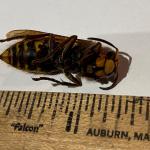 Wasps/Hornets: Many are noticing the spring time “awakening” of various species of wasps/hornets in Massachusetts at this time. Many wasps are predators of other arthropods, including pest insects such as certain caterpillars that feed on trees and shrubs. Adult wasps hunt prey and bring it back to their nest where young are being reared, as food for the immature wasps. A common such example are the paper wasps (Polistes spp.) who rear their young on chewed up insects. They may be seen searching plants for caterpillars and other soft-bodied larvae to feed their young. Paper wasps can sting, and will defend their nests, which are open-celled paper nests that are not covered with a papery “envelope”. These open-celled nests may be seen hanging from eaves or other outdoor building structures. Aerial yellow jackets and hornets create large aerial nests that are covered with a papery shell or “envelope”. Common yellow jacket species include those in the genus Vespula. Dolichovespula maculata is commonly known as the baldfaced hornet, although it is not a true hornet. The European hornet (Vespa crabro) is three times the size of a yellow jacket and may be confused for the Asian giant hornet (Vespa mandarinia). The European hornet is known to Massachusetts, but the Asian giant hornet is not. If you are concerned that you have found or photographed an Asian giant hornet, please report it here: https://massnrc.org/pests/report.aspx . A helpful ID tool, although developed for Texas by the USDA, depicts common look-a-like species that we also have in MA that can be confused for the Asian giant hornet and is found here: https://agrilife.org/lubbock/files/2020/05/Asian_Giant_Hornet_Look-alikes_101_Xanthe_Shirley.pdf Paper wasps and aerial yellowjackets overwinter as fertilized females (queens) and a single female produces a new nest annually in the late spring. Nests are abandoned at the end of the season. It is this annual behavior of queens starting new nests, laying eggs, and rearing new wasps to assist in colony/nest development that may lead people to believe that wasp/yellow jacket numbers are high at this time of year. While populations may fluctuate and insect survival may have been aided by a mild winter (although that is not always true for all species), it is difficult to tell if these insects are more numerous this year, or just that they are more noticeable now that nest construction and brood development are under way for the season. Either way, some people are allergic to stinging insects, so care should be taken around wasp/hornet nests. Unlike the European honeybee (Apis mellifera), wasps and hornets do not have barbed stingers, and therefore can sting repeatedly when defending their nests. It is best to avoid their nests, and if that cannot be done and assistance is needed to remove them, consult a professional.
Wasps/Hornets: Many are noticing the spring time “awakening” of various species of wasps/hornets in Massachusetts at this time. Many wasps are predators of other arthropods, including pest insects such as certain caterpillars that feed on trees and shrubs. Adult wasps hunt prey and bring it back to their nest where young are being reared, as food for the immature wasps. A common such example are the paper wasps (Polistes spp.) who rear their young on chewed up insects. They may be seen searching plants for caterpillars and other soft-bodied larvae to feed their young. Paper wasps can sting, and will defend their nests, which are open-celled paper nests that are not covered with a papery “envelope”. These open-celled nests may be seen hanging from eaves or other outdoor building structures. Aerial yellow jackets and hornets create large aerial nests that are covered with a papery shell or “envelope”. Common yellow jacket species include those in the genus Vespula. Dolichovespula maculata is commonly known as the baldfaced hornet, although it is not a true hornet. The European hornet (Vespa crabro) is three times the size of a yellow jacket and may be confused for the Asian giant hornet (Vespa mandarinia). The European hornet is known to Massachusetts, but the Asian giant hornet is not. If you are concerned that you have found or photographed an Asian giant hornet, please report it here: https://massnrc.org/pests/report.aspx . A helpful ID tool, although developed for Texas by the USDA, depicts common look-a-like species that we also have in MA that can be confused for the Asian giant hornet and is found here: https://agrilife.org/lubbock/files/2020/05/Asian_Giant_Hornet_Look-alikes_101_Xanthe_Shirley.pdf Paper wasps and aerial yellowjackets overwinter as fertilized females (queens) and a single female produces a new nest annually in the late spring. Nests are abandoned at the end of the season. It is this annual behavior of queens starting new nests, laying eggs, and rearing new wasps to assist in colony/nest development that may lead people to believe that wasp/yellow jacket numbers are high at this time of year. While populations may fluctuate and insect survival may have been aided by a mild winter (although that is not always true for all species), it is difficult to tell if these insects are more numerous this year, or just that they are more noticeable now that nest construction and brood development are under way for the season. Either way, some people are allergic to stinging insects, so care should be taken around wasp/hornet nests. Unlike the European honeybee (Apis mellifera), wasps and hornets do not have barbed stingers, and therefore can sting repeatedly when defending their nests. It is best to avoid their nests, and if that cannot be done and assistance is needed to remove them, consult a professional.
Woody ornamental insect and non-insect arthropod pests to consider, a selected few:
- Asian Longhorned Beetle: (Anoplophora glabripennis, ALB) Look for signs of an ALB infestation which include perfectly round exit holes (about the size of a dime), shallow oval or round scars in the bark where a female has chewed an egg site, or sawdust-like frass (excrement) on the ground nearby host trees or caught in between branches. Be advised that other, native insects may create perfectly round exit holes or sawdust-like frass, which can be confused with signs of ALB activity.
The regulated area for Asian longhorned beetle is 110 miles2 encompassing Worcester, Shrewsbury, Boylston, West Boylston, and parts of Holden and Auburn. If you believe you have seen damage caused by this insect, such as exit holes or egg sites, on susceptible host trees like maple, please call the Asian Longhorned Beetle Eradication Program office in Worcester, MA at 508-852-8090 or toll free at 1-866-702-9938.
To report an Asian longhorned beetle find online or compare it to common insect look-alikes, visit: http://massnrc.org/pests/albreport.aspx or https://www.aphis.usda.gov/pests-diseases/alb/report .
- White Spotted Pine Sawyer (WSPS): Monochamus scutellatus adults can emerge in late May throughout July, depending on local temperatures. This is a native insect in Massachusetts and is usually not a pest. Larvae develop in weakened or recently dead conifers, particularly eastern white pine (Pinus strobus). However, the white spotted pine sawyer looks very similar to the invasive Asian Longhorned Beetle, Anoplophora glabripennis, ALB. ALB adults do not emerge in Massachusetts until July and August. Beginning in July, look for the key difference between WSPS and ALB adults, which is a white spot in the top center of the wing covers (the scutellum) on the back of the beetle. White spotted pine sawyer will have this white spot, whereas Asian longhorned beetle will not. Both insects can have other white spots on the rest of their wing covers; however, the difference in the color of the scutellum is a key characteristic. See the Asian longhorned beetle entry above for more information about that non-native insect.
- Arborvitae Leafminer: In New England and eastern Canada, four species of leafminers are known to infest arborvitae. These include Argyresthia thuiella, A. freyella, A. aureoargentella, and Coleotechnites thujaella. The arborvitae leafminer, A. thuiella, is the most abundant of these and has the greatest known range when compared to the others. (It is also found in the Mid-Atlantic States and as far west as Missouri). Moths of this species appear from mid-June to mid-July and lay their eggs. The damage caused by all of these species is nearly identical. Trees, however, have been reported to lose up to 80% of their foliage due to arborvitae leafminer and still survive. At least 27 species of parasites have been reported as natural enemies of arborvitae leafminers, the most significant of which may be a parasitic wasp (Pentacnemus bucculatricis). Arborvitae leafminer damage causes the tips of shoots and foliage to turn yellow and brown. If infestations are light, prune out infested tips.
- Azalea Sawflies: There are a few species of sawflies that impact azaleas. Johnson and Lyon's Insects that Feed on Trees and Shrubs mentions three of them. Amauronematus azaleae was first reported in New Hampshire in 1895 and is likely found in most of New England. Adults of this species are black with some white markings and wasp-like. Generally green larvae feed mostly on mollis hybrid azaleas. Remember, sawfly caterpillars have at least enough abdominal prolegs to spell “sawfly” (so 6 or more prolegs). Adults are present in May, and females lay their eggs and then larvae hatch and feed through the end of June. There is one generation per year. Nematus lipovskyi has been reared from swamp azalea (Rhododendron viscosum). Adults of that species have been collected in April (in states to the south) and May (in New England) and larval feeding is predominantly in late April and May in Virginia and June in New England. One generation of this species occurs per year, and most mollis hybrid azaleas can be impacted. A third species, Arge clavicornis, is found as an adult in July and lays its eggs in leaf edges in rows. Larvae are present in August and September. Remember, Bacillus thuringiensis Kurstaki does not manage sawflies.
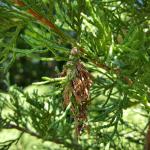 Bagworm: Thyridopteryx ephemeraeformis is a native species of moth whose larvae construct bag-like coverings over themselves with host plant leaves and twigs. This insect overwinters in the egg stage, within the bags of deceased females from last season. Eggs may hatch and young larvae are observed feeding around mid-June, or roughly between 600-900 GDD’s. Remove and destroy overwintering bags before June. In certain areas across MA in 2019, increased populations of bagworms were observed and reported. More information can be found here: https://ag.umass.edu/landscape/fact-sheets/bagworm
Bagworm: Thyridopteryx ephemeraeformis is a native species of moth whose larvae construct bag-like coverings over themselves with host plant leaves and twigs. This insect overwinters in the egg stage, within the bags of deceased females from last season. Eggs may hatch and young larvae are observed feeding around mid-June, or roughly between 600-900 GDD’s. Remove and destroy overwintering bags before June. In certain areas across MA in 2019, increased populations of bagworms were observed and reported. More information can be found here: https://ag.umass.edu/landscape/fact-sheets/bagworm- Boxwood Leafminer: Monarthropalpus flavus partly grown fly larvae overwinter in the leaves of susceptible boxwood. Yellowish mines may be noticeable on the undersides of leaves. This insect grows rapidly in the spring, transforming into an orange-colored pupa. After pupation, adults will emerge and white colored pupal cases may hang down from the underside of leaves where adults have emerged. Adults may be observed swarming hosts between 300-650 GDD’s, or roughly the end of May through June. Most cultivars of Buxus sempervirens and B. microphylla are thought to be susceptible. If installing new boxwoods this spring, resistant cultivars such as ‘Vardar Valley’ and ‘Winter Gem’ are good choices at sites where this insect has been a problem.
- Boxwood Mite: Eurytetranychus buxi overwinter as tiny eggs on boxwood leaves and hatch mid-spring. These mites are tiny (about the size of a period) and difficult to detect. Feeding may cause plants to appear off-color. If management is deemed necessary, the timing for treatment may be between 245-600 GDD’s.
- Boxwood Psyllid: Psylla buxi feeding can cause cupping of susceptible boxwood leaves. Leaf symptoms/damage may remain on plants for up to two years. English boxwood may be less severely impacted by this pest. Eggs overwinter, buried in budscales, and hatch around budbreak of boxwood. Eggs may hatch around 80 GDD’s. Foliar applications may be made between 290-440 GDD’s. However, the damage caused by this insect is mostly aesthetic. Therefore, no management may be necessary.
- Cankerworms: Alsophila pometaria (fall cankerworm) and Paleacrita vernata (spring cankerworm) are often confused for winter moth (Operophtera brumata). Cankerworm populations in eastern MA, particularly on areas of Cape Cod, were confused for winter moth in 2019. Spring cankerworm adults were active in February and March, and fall cankerworm adults are active in late November into early December. During these times, both species lay eggs. These native insects most commonly utilize elm, apple, oak, linden, and beech. Eggs of both species hatch as soon as buds begin to open in the spring. Caterpillars occur in mixed populations and are often noticeable by mid-May in MA. Young larvae will feed on buds and unfolding leaves. There are two color forms (green and dark) for caterpillars of both species. Like winter moth, they will drop to the soil to pupate. This usually occurs in June. Fall cankerworm larvae have three pairs of prolegs (one of which is small so it is sometimes referred to as ½) and spring cankerworm have two pairs. (Winter moth caterpillars also have 2 pairs of prolegs.) If populations are large and damage is noticeable on hosts, reduced risk insecticides such as Bacillus thuringiensis Kurstaki or spinosad may target larvae between 148-290 GDD’s.
- Dogwood Borer: Synanthedon scitula is a species of clearwing moth whose larvae bore not only into dogwood (Cornus), but hosts also include flowering cherry, chestnut, apple, mountain ash, hickory, pecan, willow, birch, bayberry, oak, hazel, myrtle, and others. Kousa dogwood appear to be resistant to this species. Signs include the sloughing of loose bark, brown frass, particularly near bark cracks and wounds, dead branches, and adventitious growth. The timing of adult emergence can be expected when dogwood flower petals are dropping and weigela begins to bloom. Adult moth flights continue from then until September. Emergence in some hosts (ex. apple) appears to be delayed, but this differs depending upon the location in this insect’s range. Eggs are laid singly, or in small groups, on smooth and rough bark. Female moths preferentially lay eggs near wounded bark. After hatch, larvae wander until they find a suitable entrance point into the bark. This includes wounds, scars, or branch crotches. This insect may also be found in twig galls caused by other insects or fungi. Larvae feed on phloem and cambium. Fully grown larvae are white with a light brown head and approx. ½ inch long. Pheromone traps and lures are useful for determining the timing of adult moth emergence and subsequent management.
 Eastern Tent Caterpillar: Malacosoma americanum eggs overwinter on host plant twigs. Egg hatch typically occurs when wild cherry leaves begin to unfold and young caterpillars may emerge by late-April through the first two weeks in May (90-190 GDD’s). Eastern tent caterpillars were seen creating webbing and feeding in Chesterfield, MA on 5/19/2020 and again on 5/26/2020. Susceptible hosts include cherry and crabapple. Other host plants whose leaves are fed upon by this native insect can include apple, ash, birch, willow, maple, oak, poplar, and witch-hazel. Eastern tent caterpillars are native to Massachusetts and have many associated natural enemies (parasites and predators) that help regulate populations. Unless these caterpillars are actively defoliating specimen trees in a landscaped setting, we can coexist with this particular herbivore native to our forests.
Eastern Tent Caterpillar: Malacosoma americanum eggs overwinter on host plant twigs. Egg hatch typically occurs when wild cherry leaves begin to unfold and young caterpillars may emerge by late-April through the first two weeks in May (90-190 GDD’s). Eastern tent caterpillars were seen creating webbing and feeding in Chesterfield, MA on 5/19/2020 and again on 5/26/2020. Susceptible hosts include cherry and crabapple. Other host plants whose leaves are fed upon by this native insect can include apple, ash, birch, willow, maple, oak, poplar, and witch-hazel. Eastern tent caterpillars are native to Massachusetts and have many associated natural enemies (parasites and predators) that help regulate populations. Unless these caterpillars are actively defoliating specimen trees in a landscaped setting, we can coexist with this particular herbivore native to our forests.- Elongate Hemlock Scale: Fiorinia externa is found on eastern, Carolina, and Japanese hemlock, as well as yew, spruce, and fir. The elongate hemlock scale may overwinter in various life stages, and overlap of many developmental stages at any given time can be observed throughout much of the season. Dormant oil applications for this pest can occur according to label instructions in April, roughly between 7-120 GDD’s. Treatments for the crawler, or mobile, stage of this insect may be made in late May through mid-June, or between 360-700 GDD’s, base 50°F. Nitrogen fertilizer applications may make elongate hemlock scale infestations worse.
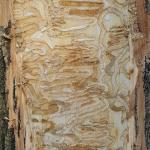 Emerald Ash Borer: (Agrilus planipennis, EAB) Since the New Year, the Massachusetts Department of Conservation and Recreation has confirmed at least 18 new community detections of emerald ash borer in Massachusetts. While the cities and towns with recent detections of EAB are too numerous to list here, they are in areas of Essex, Franklin, Hampshire, Middlesex, Norfolk, and Worcester counties. It is worthwhile to note that this was the first detection of EAB in Franklin County. A map of these locations and others previously known across the state may be found here: https://ag.umass.edu/fact-sheets/emerald-ash-borer .
Emerald Ash Borer: (Agrilus planipennis, EAB) Since the New Year, the Massachusetts Department of Conservation and Recreation has confirmed at least 18 new community detections of emerald ash borer in Massachusetts. While the cities and towns with recent detections of EAB are too numerous to list here, they are in areas of Essex, Franklin, Hampshire, Middlesex, Norfolk, and Worcester counties. It is worthwhile to note that this was the first detection of EAB in Franklin County. A map of these locations and others previously known across the state may be found here: https://ag.umass.edu/fact-sheets/emerald-ash-borer .
This wood-boring beetle readily attacks ash (Fraxinus spp.) including white, green, and black ash and has also been found developing in white fringe tree (Chionanthus virginicus) and has been reported in cultivated olive (Olea europaea). Adult insects of this species will not be present at this time of year. Signs of an EAB infested tree may include (at this time) D-shaped exit holes in the bark (from adult emergence in previous years), “blonding” or lighter coloration of the ash bark from woodpecker feeding (chipping away of the bark as they search for larvae beneath), and serpentine galleries visible through splits in the bark, from larval feeding beneath. Positive identification of an EAB-infested tree may not be possible with these signs individually on their own.
For further information about this insect, please visit: https://ag.umass.edu/fact-sheets/emerald-ash-borer . If you believe you have located EAB-infested ash trees, particularly in an area of Massachusetts not identified on the map provided, please report here: http://massnrc.org/pests/pestreports.htm .
 Eriophyid Mites: these insect relatives are known to create different types of leaf galls on certain host plants. The crimson erineum mite or Eriophyes elongates is one of my favorites. This insect can be found on the leaves of sugar maple, creating felt patches on the upper leaf surface that appear pink, or a deep crimson red. The crimson erineum mite was seen on sugar maple in Chesterfield, MA on 5/28/2020. Like the vast majority of leaf galls, the crimson erineum mite does not cause significant injury to its host plant, and therefore management is not necessary.
Eriophyid Mites: these insect relatives are known to create different types of leaf galls on certain host plants. The crimson erineum mite or Eriophyes elongates is one of my favorites. This insect can be found on the leaves of sugar maple, creating felt patches on the upper leaf surface that appear pink, or a deep crimson red. The crimson erineum mite was seen on sugar maple in Chesterfield, MA on 5/28/2020. Like the vast majority of leaf galls, the crimson erineum mite does not cause significant injury to its host plant, and therefore management is not necessary.- Euonymus Caterpillar: Yponomeuta cagnagella is of European origin and widespread in distribution throughout Europe. It was first reported in North America in Ontario in 1967. The euonymus caterpillars (larvae) feed in groups and envelop the foliage of the host plant in webs as they feed. Hosts include: Euonymus europaeus (tree form), E. kiautschovicus, E. alatus, and E. japonicus. Mature caterpillars are just under an inch in length, creamy yellow-gray in color with black spots and a black head capsule.
 By late June, these larvae pupate in white, oval-shaped cocoons which are typically oriented together vertically either on host plants or non-hosts in the area. Cocoons can be found in cracks and crevices, or webbed together leaves. The adult moth emerges in late June in most locations. The adult female secretes a gummy substance over her eggs which will harden, making them even more difficult to see. Eggs hatch by mid-August, at which time the tiny larvae prepare to overwinter beneath their eggshell-like covering. These larvae are inactive until the following year, when caterpillars group together to feed on newly emerging leaves, creating a mess of webs as they feed. There is one generation per year. Plants may be partially or entirely defoliated. Management of young, actively feeding caterpillars with Bacillus thuringiensis is possible if deemed necessary, however many species of Euonymus are considered invasive themselves.
By late June, these larvae pupate in white, oval-shaped cocoons which are typically oriented together vertically either on host plants or non-hosts in the area. Cocoons can be found in cracks and crevices, or webbed together leaves. The adult moth emerges in late June in most locations. The adult female secretes a gummy substance over her eggs which will harden, making them even more difficult to see. Eggs hatch by mid-August, at which time the tiny larvae prepare to overwinter beneath their eggshell-like covering. These larvae are inactive until the following year, when caterpillars group together to feed on newly emerging leaves, creating a mess of webs as they feed. There is one generation per year. Plants may be partially or entirely defoliated. Management of young, actively feeding caterpillars with Bacillus thuringiensis is possible if deemed necessary, however many species of Euonymus are considered invasive themselves.
Want to see euonymus caterpillars in action?! I bet you’ve never seen so many of these caterpillars in one place! Check out Episode 3 of InsectXaminer: https://ag.umass.edu/landscape/education-events/insectxaminer .
- Euonymus Scale: Unaspis euonymi is an armored scale that can be found on euonymus, holly, bittersweet, and pachysandra. This insect can cause yellow spotting on leaves, dieback, and distorted bark. Dormant oil applications can be made between 35-120 GDD’s or roughly from mid-April to early-May. For crawlers, early June timing is suggested between 533-820 GDD’s. (Eggs begin to hatch in early June.)
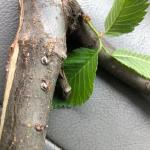 European Elm Scale: Gossyparia spuria is a type of felt scale and was reported to UMass Extension as active in Quincy, MA on 6/3/20. First noted in New York in 1884, this non-native scale is now widespread in North America and is found on native and European elms, but also rarely on hackberry and Zelkova. This insect can cause yellowing of foliage, premature leaf drop, and eventually dieback on its host. Honeydew and thus sooty mold are produced. The females observed in Quincy, MA have produced a ring of white fibers around their black, oval bodies. By the end of June, these females will lay eggs that hatch into bright yellow crawlers, which will disperse to the midrib and leaf veins on the underside of elm leaves where they will remain to feed. Crawlers are tiny and magnification is necessary to observe. Natural enemies such as parasitic wasps and predatory insects have been reported as successful in managing this insect.
European Elm Scale: Gossyparia spuria is a type of felt scale and was reported to UMass Extension as active in Quincy, MA on 6/3/20. First noted in New York in 1884, this non-native scale is now widespread in North America and is found on native and European elms, but also rarely on hackberry and Zelkova. This insect can cause yellowing of foliage, premature leaf drop, and eventually dieback on its host. Honeydew and thus sooty mold are produced. The females observed in Quincy, MA have produced a ring of white fibers around their black, oval bodies. By the end of June, these females will lay eggs that hatch into bright yellow crawlers, which will disperse to the midrib and leaf veins on the underside of elm leaves where they will remain to feed. Crawlers are tiny and magnification is necessary to observe. Natural enemies such as parasitic wasps and predatory insects have been reported as successful in managing this insect.- European Pine Sawfly: Neodiprion sertifer overwinters in the egg stage. Eggs are laid by females the previous season by cutting slits in needles using their ovipositors and depositing 6-8 eggs in each of 10-12 needles. Egg hatch occurs from late-April to mid-May and caterpillars become active roughly between 78-220 GDD, base 50°F. The primary host in MA is Mugo pine but it can be found on Scots, red, jack, and Japanese red pine. It is also found on white, Austrian, ponderosa, shortleaf, and pitch pine when planted near the aforementioned species. This dark colored caterpillar feeds in tight groups and small numbers can be pruned or plucked out of host plants and destroyed. Spinosad products can be used whenever the caterpillars are actively feeding, usually by mid-May and when caterpillars are still small. Bacillus thuringiensis kurstaki is not effective against sawflies.
- Fletcher Scale: Parthenolecanium fletcheri is a soft scale pest of yew, juniper, and arborvitae. Feeding scales, especially on yew, result in honeydew and sooty mold, needle yellowing, and at times, premature needle drop. There is one generation per year. Overwintered second instar nymphs can be targeted between 38-148 GDD’s, base 50°F. Nymphs develop and adult females lay eggs (on average 500-600) in May that hatch by June. Dead females conceal egg masses beneath. Crawlers migrate short distances to branches and may be concentrated on certain branches of a particular plant.
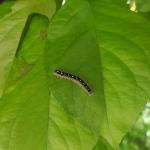 Forest Tent Caterpillar: Malacosoma disstria egg hatch occurs between 192-363 GDD’s, base 50°F, by mid-late May and caterpillars may be active for at least 5-6 weeks following. Susceptible hosts whose leaves are fed on by this insect include oak, birch, ash, maple, elm, poplar, and basswood. This native insect has many natural enemies, including some very effective pathogens that typically regulate populations. However, outbreaks of this insect can occur on occasion.
Forest Tent Caterpillar: Malacosoma disstria egg hatch occurs between 192-363 GDD’s, base 50°F, by mid-late May and caterpillars may be active for at least 5-6 weeks following. Susceptible hosts whose leaves are fed on by this insect include oak, birch, ash, maple, elm, poplar, and basswood. This native insect has many natural enemies, including some very effective pathogens that typically regulate populations. However, outbreaks of this insect can occur on occasion.- Gypsy Moth:(Lymantria dispar) thanks to the gypsy moth caterpillar killing fungus, Entomophaga maimaiga, the recent outbreak of gypsy moth in Massachusetts has come to an end! Most locations in Massachusetts will not see damaging or even noticeable populations of this insect in 2020. However, that does not mean the occasional egg mass won’t be seen in certain areas of the state. Egg hatch was observed and reported with photo evidence in Shelburne Falls, MA on 5/4/2020. Shadbush (Amelanchier spp.) was reported as in full bloom at the same time in that area. A young gypsy moth caterpillar was seen feeding on willow in Chesterfield, MA on 6/3/20, despite the relative lack of overwintering gypsy moth egg masses in the area. The impact of gypsy moth in this particular hilltown in Hampshire County has been negligible.
-
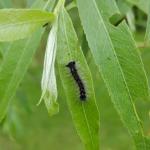 Gypsy moth has been in Massachusetts since the 1860's. This invasive insect from Europe often goes unnoticed, thanks to population regulation provided by the entomopathogenic fungus, E. maimaiga, as well as a NPV virus specific to gypsy moth caterpillars. (And to a lesser extent many other organisms, including other insects, small mammals, and birds who feed on gypsy moth.) However, if environmental conditions do not favor the life cycle of the fungus, outbreaks of gypsy moth caterpillars are possible. (Such as most recently from 2015-2018, with a peak in the gypsy moth population in 2017 in Massachusetts.)
Gypsy moth has been in Massachusetts since the 1860's. This invasive insect from Europe often goes unnoticed, thanks to population regulation provided by the entomopathogenic fungus, E. maimaiga, as well as a NPV virus specific to gypsy moth caterpillars. (And to a lesser extent many other organisms, including other insects, small mammals, and birds who feed on gypsy moth.) However, if environmental conditions do not favor the life cycle of the fungus, outbreaks of gypsy moth caterpillars are possible. (Such as most recently from 2015-2018, with a peak in the gypsy moth population in 2017 in Massachusetts.)
Missing gypsy moth already? Check out Episode 1 of InsectXaminer to reminisce about the 2015-2018 outbreak of this insect: https://ag.umass.edu/landscape/education-events/insectxaminer
- Hemlock Looper: Two species of geometrid moths in the genus Lambdina are native insects capable of defoliating eastern hemlock, balsam fir, and white spruce. Adult moths lay their eggs on the trunk and limbs of hosts in September and October, and eggs will hatch by late May or early June. (L. fiscellaria caterpillars may be active between 448-707 GDD’s.) Monitor susceptible hosts for small, inch-worm like caterpillars. Where populations are low, no management is necessary. Hemlock loopers have several effective natural enemies.
- Hemlock Woolly Adelgid: Adelges tsugae is present on eastern and Carolina hemlock. The overwintering hemlock woolly adelgid generation (sistens) is present through mid-spring and produces the spring generation (progrediens) which will be present from early spring through mid-summer. HWA, unlike many other insects, does most of its feeding over the winter. Eggs may be found in woolly masses at the base of hemlock needles beginning in mid-March. Each woolly mass is created by a female who may then lay 50-300 eggs. Eggs hatch and crawlers may be found from mid-March through mid-July. Infested trees may be treated with foliar sprays in late April to early May, using Japanese quince as a phenological indicator. Systemic applications may be made in the spring and fall, or when soil conditions are favorable for translocation to foliage. Nitrogen fertilizer applications may make hemlock woolly adelgid infestations worse.
- Holly Leafminers: Seven species of leaf miners feed on holly. Phytomyza ilicicola is usually referred to as the native holly leafminer. This species is known to feed on Ilex opaca, I. crenata, and related cultivars; however, it only lays its eggs in American holly (Ilex opaca). Some research suggests that the native holly leafminer may lay its eggs in other Ilex species, but that the larvae are unable to complete their development. This insect is found throughout the native range of its host plants. Larvae overwinter in leaf mines and pupation occurs in March and April and adult emergence by mid-May (192-298 GDD’s, base 50°F). Adult flies are known to emerge over a period of 6 or so weeks in the spring. Females lay eggs using their ovipositor on the underside of newly formed leaves. A tiny green blister forms on the leaf as the first symptom of injury. Larvae hatch from the egg and create a narrow mine that may appear brown from the upper leaf surface. Mines are broadened in the fall and a large blotch is completed in the winter. Larvae are yellow maggots and reach 1.5 mm. in length when mature. Current year’s mines are easily overlooked due to the slow feeding patterns of the larvae. Premature leaf drop may occur. Remove and destroy mined leaves before May. Phytomyza ilicis is usually only referred to as the holly leafminer, and it is a non-native species introduced from Europe and only feeds on Ilex aquifolium. (The native holly leaf miner does not develop in I. aquifolium.) The biology and damage this insect causes is similar to that of the native holly leafminer, with the exception of the fact that eggs are laid in the midvein of the leaf and young larvae tunnel in the vein until the fall. Remove and destroy mined leaves before May. Adults may be present mid-late May (246-448 GDD’s, base 50°F).
- Honeylocust Plant Bug: Diaphnocoris chlorionis feeding results in tiny yellowish-brownish spots on leaves, leaf distortion, and in some cases, defoliation. (There are at least 7 species of plant bugs that feed on honeylocust, Gleditsia triacanthos.) There is one generation per year. Immatures and adults feed on foliage and light to moderately damaged foliage may persist throughout the growing season. Honeylocust plant bugs overwinter as eggs laid just beneath the bark surface of 2 and 3 year old twigs. Eggs hatch just after vegetative bugs of the host begin to open. Young nymphs crawl to the opening leaflets and begin feeding and the most significant damage occurs at that time, when the insect is hidden from view. Nymphs develop into adults around May-July. This insect can be targeted between 58-246 GDD’s, base 50°F.
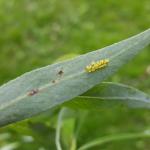
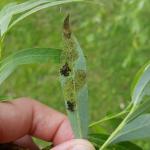 Imported Willow Leaf Beetle: Plagiodera versicolora adult beetles overwinter near susceptible hosts. Adult beetles will chew holes and notches in the leaves of willow once they become available. Imported willow leaf beetle adults were observed feeding and mating in Chesterfield, MA on 5/20/2020. Adults continue to feed and mate on 5/26/2020 and egg laying has been observed. Females lay yellow eggs in clusters on the undersides of leaves. While clusters of yellow eggs can still be found, tiny larvae have hatched and are beginning to skeletonize willow leaves, as observed on 6/3/20 in Chesterfield, MA. Larvae are slug-like and bluish-green in color. They will feed in clusters and skeletonize the leaves. Most plants can tolerate the feeding from this insect, and foliage will appear brown. Repeated yearly feeding can be an issue, in which case management of the young larvae may be necessary. Take care with treatment in areas near water.
Imported Willow Leaf Beetle: Plagiodera versicolora adult beetles overwinter near susceptible hosts. Adult beetles will chew holes and notches in the leaves of willow once they become available. Imported willow leaf beetle adults were observed feeding and mating in Chesterfield, MA on 5/20/2020. Adults continue to feed and mate on 5/26/2020 and egg laying has been observed. Females lay yellow eggs in clusters on the undersides of leaves. While clusters of yellow eggs can still be found, tiny larvae have hatched and are beginning to skeletonize willow leaves, as observed on 6/3/20 in Chesterfield, MA. Larvae are slug-like and bluish-green in color. They will feed in clusters and skeletonize the leaves. Most plants can tolerate the feeding from this insect, and foliage will appear brown. Repeated yearly feeding can be an issue, in which case management of the young larvae may be necessary. Take care with treatment in areas near water.- Lacebugs: Stephanitis spp. lacebugs such as S. pyriodes can cause severe injury to azalea foliage. S. rhododendri can be common on Rhododendron and mountain laurel. S. takeyai has been found developing on Japanese Andromeda, Leucothoe, Styrax, and willow. Stephanitis spp. lace bug activity should be monitored through September. Before populations become too large, treat with a summer rate horticultural oil spray as needed. Be sure to target the undersides of the foliage in order to get proper coverage of the insects. Certain azalea and Andromeda cultivars may be less preferred by lace bugs.
- Lecanium Scales (Oak): Parthenolecanium quercifex overwinters as a second instar nymph on oak twigs. Females will begin feeding and mature in the spring, from mid-April to early May and eggs may be laid between late May and into June. Eggs hatch in June or early July and crawlers migrate to host plant leaves where they spend the summer and migrate as second instars back to host plant twigs in the fall. Mid-April to early-May (35-145 GDD’s) for dormant oil applications.
- Lilac Borer: Podosesia syringae is a clearwing moth pest of lilac, privet, fringetree, and ash. (It is also known as the ash borer, not to be confused with the emerald ash borer.) Adults mimic paper wasps. Larvae are wood-boring, and signs and symptoms include branch dieback, holes, and occasionally, sawdust-like frass accumulated on bark. Larvae bore into stems, trunks, and branches, chewing an irregularly shaped entrance hole. Peak adult moth flights may occur in the northern portion of this insect’s range in June and is usually over by August 1st. Pheromone traps can be used to time adult emergence. Adult females lay flattened, oval, and tan eggs that are deposited singly or in clusters on bark crevices, ridges, and sometimes smooth bark; but usually laid in or near wounds in the bark. On average, 395 eggs are laid by each female. After hatch, larvae chew into the bark and feed laterally and then vertically in phloem tissue. Larvae overwinter in tunnels in the final instar and resume feeding in the spring. Adults emerge through a round exit hole (4-5 mm. in diameter). This insectmay be targeted between 200-299 GDD’s, base 50°F.
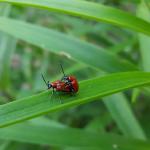 Lily Leaf Beetle: Lilioceris lilii adults overwinter in sheltered places. As soon as susceptible hosts such as Lilium spp. (Turk’s cap, tiger, Easter, Asiatic, and Oriental lilies) and Fritillaria spp. break through the ground, the adult lily leaf beetles are known to feed on the new foliage. (Note: daylilies are not hosts.) Typically, in May, mating will occur and each female will begin to lay 250-450 eggs in neat rows on the underside of the foliage. If there are only a few plants in the garden, hand picking and destroying overwintering adults can help reduce local garden-level populations at this time. For more information about this insect, visit the newly updated fact sheet: https://ag.umass.edu/landscape/fact-sheets/lily-leaf-beetle .
Lily Leaf Beetle: Lilioceris lilii adults overwinter in sheltered places. As soon as susceptible hosts such as Lilium spp. (Turk’s cap, tiger, Easter, Asiatic, and Oriental lilies) and Fritillaria spp. break through the ground, the adult lily leaf beetles are known to feed on the new foliage. (Note: daylilies are not hosts.) Typically, in May, mating will occur and each female will begin to lay 250-450 eggs in neat rows on the underside of the foliage. If there are only a few plants in the garden, hand picking and destroying overwintering adults can help reduce local garden-level populations at this time. For more information about this insect, visit the newly updated fact sheet: https://ag.umass.edu/landscape/fact-sheets/lily-leaf-beetle .
Want to learn more about lily leaf beetle’s life cycle and learn to recognize adults, larvae, and eggs? Take 3 minutes to watch Episode 2 of InsectXaminer, here: https://ag.umass.edu/landscape/education-events/insectxaminer .
- Magnolia Scale: Neolecanium cornuparvum overwinters as first instar nymphs which are elliptical, and dark slate gray in color and can usually be found on the undersides of 1 and 2 year old twigs. Nymphs may molt by late April or May and again by early June at which time the scales may be purple in color. Eventually nymphs secrete a white powdery layer of wax over their bodies.
- Rhododendron Borer: Synanthedon rhododendri is one of the smallest of the native clearwing moths. Rhododendrons are preferred hosts, although mountain laurel, and deciduous azaleas can be heavily infested, especially if they are planted in close proximity to rhododendrons. Injury may be first noticed in the fall (leaves lose their sheen, then become pale green, then olive, then chlorotic) and can look similar to drought stress. On branches that seem to be stunted, look at limb crotches, scars, and other irregularities for sawdust stuck on bark or on the ground beneath these areas. In late May and early June, holes may contain pupal shed skins extending halfway out. Moth emergence occurs in the late-spring, early-summer. After mating, female moths seek out suitable egg laying locations (preferring wounded areas or limb crotches). The female lays her eggs and dies. Eggs hatch and larvae tunnel into the inner bark where they feed in tunnels that become packed with reddish frass pellets. By late fall, larvae move to the sapwood where they overwinter and resume feeding by mid-March. Pupation occurs in the spring and there is one generation per year. Prune out and destroy infested branches before late May/June. Monitor for adults in mid-May (192-298 GDD’s, base 50°F).
- Roseslugs: Two species of sawfly can be found on the leaves of roses at this time. These small, caterpillar-like larvae will skeletonize the upper leaf surface and leave a “window-pane” like pattern behind. When present in large numbers, these insects are capable of defoliating their entire host. Management options include an insecticidal soap spray or a product containing spinosad.
 Spotted Lanternfly: (Lycorma delicatula, SLF) is not known to occur in Massachusetts landscapes (no established populations are known in MA at this time). However, due to the great ability of this insect to hitchhike using human-aided movement, it is important that we remain vigilant in Massachusetts and report any suspicious findings. Spotted lanternfly reports can be sent here:https://massnrc.org/pests/slfreport.aspx
Spotted Lanternfly: (Lycorma delicatula, SLF) is not known to occur in Massachusetts landscapes (no established populations are known in MA at this time). However, due to the great ability of this insect to hitchhike using human-aided movement, it is important that we remain vigilant in Massachusetts and report any suspicious findings. Spotted lanternfly reports can be sent here:https://massnrc.org/pests/slfreport.aspx
For a map of known, established populations of SLF as well as detections outside of these areas where individual finds of spotted lanternfly have occurred (but no infestations are present), visit: https://nysipm.cornell.edu/environment/invasive-species-exotic-pests/spotted-lanternfly/ This map depicts an individual find of spotted lanternfly at a private residence in Boston, MA that was reported by the MA Department of Agricultural Resources on February 21, 2019. More information about this detection in Boston, where no established infestation was found, is provided here: https://www.mass.gov/news/state-agricultural-officials-urge-residents-to-check-plants-for-spotted-lanternfly
This insect is a member of the Order Hemiptera (true bugs, cicadas, hoppers, aphids, and others) and the Family Fulgoridae, also known as planthoppers. The spotted lanternfly is a non-native species first detected in the United States in Berks County, Pennsylvania and confirmed on September 22, 2014.
The spotted lanternfly is considered native to China, India, and Vietnam. It has been introduced as a non-native insect to South Korea and Japan, prior to its detection in the United States. In South Korea, it is considered invasive and a pest of grapes and peaches. The spotted lanternfly has been reported from over 70 species of plants, including the following: tree of heaven (Ailanthus altissima) (preferred host), apple (Malus spp.), plum, cherry, peach, apricot (Prunus spp.), grape (Vitis spp.), pine (Pinus spp.), pignut hickory (Carya glabra), sassafras (Sassafras albidum), serviceberry (Amelanchier spp.), slippery elm (Ulmus rubra), tulip poplar (Liriodendron tulipifera), white ash (Fraxinus americana), willow (Salix spp.), American beech (Fagus grandifolia), American linden (Tilia americana), American sycamore (Platanus occidentalis), big-toothed aspen (Populus grandidentata), black birch (Betula lenta), black cherry (Prunus serotina), black gum (Nyssa sylvatica), black walnut (Juglans nigra), dogwood (Cornus spp.), Japanese snowbell (Styrax japonicus), maple (Acer spp.), oak (Quercus spp.), and paper birch (Betula papyrifera).
The adults and immatures of this species damage host plants by feeding on sap from stems, leaves, and the trunks of trees. In the springtime in Pennsylvania (late April - mid-May) nymphs (immatures) are found on smaller plants and vines and new growth of trees and shrubs. Third and fourth instar nymphs migrate to the tree of heaven and are observed feeding on trunks and branches. Trees may be found with sap weeping from the wounds caused by the insect’s feeding. The sugary secretions (excrement) created by this insect may coat the host plant, later leading to the growth of sooty mold. Insects such as wasps, hornets, bees, and ants may also be attracted to the sugary waste created by the lanternflies, or sap weeping from open wounds in the host plant. Host plants have been described as giving off a fermented odor when this insect is present.
Adults are present by the middle of July in Pennsylvania and begin laying eggs by late September and continue laying eggs through late November and even early December in that state. Adults may be found on the trunks of trees such as the tree of heaven or other host plants growing in close proximity to them. Egg masses of this insect are gray in color and look similar in some ways to gypsy moth egg masses.
Host plants, bricks, stone, lawn furniture, recreational vehicles, and other smooth surfaces can be inspected for egg masses. Egg masses laid on outdoor residential items such as those listed above may pose the greatest threat for spreading this insect via human aided movement.
For more information about the spotted lanternfly, visit this fact sheet: https://ag.umass.edu/landscape/fact-sheets/spotted-lanternfly .
- Spruce Bud Scale: Physokermes piceae is a pest of Alberta and Norway spruce, among others. Immatures overwinter on the undersides of spruce needles, dormant until late March. By April, females may move to twigs to complete the rest of their development. Mature scales are reddish brown, globular, 3 mm. in diameter, and found in clusters of 3-8 at the base of new twig growth. They closely resemble buds and are often overlooked. Crawlers are present around June.
- Spruce Spider Mite: Oligonychus ununguis is a cool-season mite that becomes active in the spring from tiny eggs that have overwintered on host plants. Hosts include spruce, arborvitae, juniper, hemlock, pine, Douglas-fir, and occasionally other conifers. This particular species becomes active in the spring and can feed, develop, and reproduce through roughly June. When hot, dry summer conditions begin, this spider mite will enter a summer-time dormant period (aestivation) until cooler temperatures return in the fall. This particular mite may prefer older needles to newer ones for food. When damaging spruce spider mite populations are known from last season, dormant oil applications can be made (when temperatures are appropriate according to label instructions) between 7-121 GDD’s, base 50°F (April). Magnification is required to view spruce spider mite eggs. Tapping host plant branches over white paper may be a useful tool when scouting for spider mite presence. (View with a hand lens.) Spider mite damage may appear on host plant needles as yellow stippling and occasionally fine silk webbing is visible.
- Taxus Mealybug: Dysmicoccus wistariae will produce honeydew and lead to sooty mold growth, yellowing of needles, and sparsely foliated plants. Eventual dieback may be possible. This species is commonly associated with taxus in New England, but can be occasionally found on dogwood, rhododendron, Prunus spp., maple, Andromeda, and crabapple. These mealybugs are found on stems and branches and particularly like to congregate at branch crotches. Taxus mealybug feeds in the inner bark tissue of the trunk and branches. Adult females are present from June to August and give birth to living young in the summer. Immatures overwinter. A single generation may occur per year in New England, but areas to the south can have multiple generations of this insect. Management may be targeted between 246-618 GDD’s, base 50°F. Horticultural oil and neem oil may be used.
- Twolined Chestnut Borer: Agrilus bilineatus is a native jewel beetle (also known as a flatheaded borer) in the Family Buprestidae. This insect is also in the same genus as the invasive emerald ash borer. The twolined chestnut borer is native to Massachusetts, much of New England, and the eastern United States. This species has one generation per year and adults are typically active from April – August, depending upon location and temperature. Adults will conduct some maturation feeding on oak prior to mating. Females will lay clusters of tiny eggs in the cracks and crevices of bark. Larvae hatch from the eggs in 1-2 weeks and burrow through the bark into the cambium, where they feed in a similar manner to the emerald ash borer, creating meandering galleries as they feed. (The galleries of the twolined chestnut borer can be straight in very stressed trees.) Larvae typically mature by August – October and burrow to the outer bark where they create a chamber in which they overwinter. Pupation occurs the following spring and adults emerge through D-shaped exit holes that are approximately 1/5 inch wide. In the northern extent of this insect’s range, they can take 2 years to complete their life cycle. Larvae of this insect have been recorded from eastern white oak, common post oak, burr oak, scarlet oak, northern red oak, and eastern black oak. Adults have been recorded on fir and pin oak. These insects are attracted to stressed host plants and typically become a secondary factor in the decline of the tree.
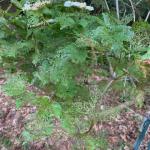
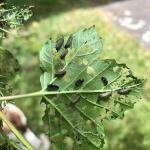 Viburnum Leaf Beetle: Pyrrhalta viburni is a beetle in the family Chrysomelidae that is native to Europe, but was found in Massachusetts in 2004. Viburnum leaf beetle overwinters as eggs laid in capped pits on the newest growth of susceptible viburnum branches. Egg hatch occurs in late-April to early-May as temperatures warm and foliage becomes available. Monitor for larvae in mid-May (80-120 GDD’s). Recently, reports of Viburnum leaf beetle larval feeding to UMass Extension have increased, likely because feeding damage is more apparent at this time. Feeding larvae were seen and reported on 5/31/20 in Southampton, MA and Pelham, MA. This beetle feeds exclusively on many different species of viburnum, which includes, but is not limited to, susceptible plants such as V. dentatum, V. nudum, V. opulus, V. propinquum, and V. rafinesquianum. Some viburnum have been observed to have varying levels of resistance to this insect, including but not limited to V. bodnantense, V. carlesii, V. davidii, V. plicatum, V. rhytidophyllum, V. setigerum, and V. sieboldii. More information about viburnum leaf beetle may be found at http://www.hort.cornell.edu/vlb/
Viburnum Leaf Beetle: Pyrrhalta viburni is a beetle in the family Chrysomelidae that is native to Europe, but was found in Massachusetts in 2004. Viburnum leaf beetle overwinters as eggs laid in capped pits on the newest growth of susceptible viburnum branches. Egg hatch occurs in late-April to early-May as temperatures warm and foliage becomes available. Monitor for larvae in mid-May (80-120 GDD’s). Recently, reports of Viburnum leaf beetle larval feeding to UMass Extension have increased, likely because feeding damage is more apparent at this time. Feeding larvae were seen and reported on 5/31/20 in Southampton, MA and Pelham, MA. This beetle feeds exclusively on many different species of viburnum, which includes, but is not limited to, susceptible plants such as V. dentatum, V. nudum, V. opulus, V. propinquum, and V. rafinesquianum. Some viburnum have been observed to have varying levels of resistance to this insect, including but not limited to V. bodnantense, V. carlesii, V. davidii, V. plicatum, V. rhytidophyllum, V. setigerum, and V. sieboldii. More information about viburnum leaf beetle may be found at http://www.hort.cornell.edu/vlb/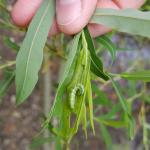 Winter Moth: (Operophtera brumata) data since 2017 has indicated that the winter moth population in eastern Massachusetts has been on the decline while the percent of winter moth pupae parasitized by Cyzenis albicans has increased! This is excellent news, as it is data supporting the evidence that winter moth populations have decreased while the parasitic fly, C. albicans, has become established at many locations in New England. Dr. Joseph Elkinton’s laboratory at UMass Amherst has released this biological control of winter moth since 2005 and conducted the rigorous sampling required to determine where the insect has established and what its impact on the winter moth population has been at multiple sites in eastern MA. More information about the Elkinton Lab’s research and the biological control of winter moth can be found here: https://www.fs.fed.us/foresthealth/technology/pdfs/FHAAST-2018-03_Biology_Control_Winter-Moth.pdf
Winter Moth: (Operophtera brumata) data since 2017 has indicated that the winter moth population in eastern Massachusetts has been on the decline while the percent of winter moth pupae parasitized by Cyzenis albicans has increased! This is excellent news, as it is data supporting the evidence that winter moth populations have decreased while the parasitic fly, C. albicans, has become established at many locations in New England. Dr. Joseph Elkinton’s laboratory at UMass Amherst has released this biological control of winter moth since 2005 and conducted the rigorous sampling required to determine where the insect has established and what its impact on the winter moth population has been at multiple sites in eastern MA. More information about the Elkinton Lab’s research and the biological control of winter moth can be found here: https://www.fs.fed.us/foresthealth/technology/pdfs/FHAAST-2018-03_Biology_Control_Winter-Moth.pdf
The take-home point? Do not worry about winter moth this spring! In fact, management of this insect in landscaped settings likely will not be necessary in most locations. In recent years, it is worth-while to note that some areas on the Cape and other locations in eastern MA have reported noticeable cankerworm populations in the spring, which are often confused for winter moth. Winter moth larvae drop to the soil to pupate by late May/early June, at which time, management is no longer necessary for the current year.
In landscape settings in eastern Massachusetts, it is best to wait until the leaves of susceptible hosts completely unfold and monitor for feeding caterpillars, prior to treatment, especially since populations in Massachusetts continue to be so low in many locations. Be sure that management of this insect is necessary by monitoring for damaging populations before making applications in landscape settings. For more information about the life cycle and management of winter moth, please visit thisfact sheet: Winter Moth Identification and Management ( https://ag.umass.edu/landscape/fact-sheets/winter-moth-identification-management ).
Winter moth is a non-native insect that was identified in Massachusetts for the first time in 2003 following persistent reports of defoliation in eastern areas of the state such as Cape Anne and on the North Shore near Cohasset, Hingham, and Rockland on the South Shore in the late 1990’s. For more detailed information about the history of this insect pest in North America and Massachusetts, please visit this fact sheet: Winter Moth in Massachusetts: History and Biological Control ( https://ag.umass.edu/landscape/fact-sheets/winter-moth-in-massachusetts-history-biological-control ).
- Woolly Elm Aphid: Eriosoma americanum females lay a single egg in the cracks and crevices of elm bark, where the egg overwinters. Eggs hatch on elm in the spring as leaves are unfolding. Aphids may be active from 121-246 GDD’s, base 50°F on elm. A young, wingless female hatched from the egg feeds on the underside of leaf tissue. This female aphid matures and gives birth to 200 young, all females, without mating. These aphids feed, and the elm leaf curls around them and protects them. By the end of June, winged migrants mature and find serviceberry hosts. Another set of females is produced. These new females crawl to and begin feeding on the roots of serviceberry. Multiple generations occur on the roots of serviceberry through the summer.
Concerned that you may have found an invasive insect or suspicious damage caused by one? Need to report a pest sighting? If so, please visit the Massachusetts Introduced Pests Outreach Project: http://massnrc.org/pests/pestreports.htm .
A note about Tick Awareness: deer ticks (Ixodes scapularis), the American dog tick (Dermacentor variabilis), and the lone star tick (Amblyomma americanum) are all found throughout Massachusetts. Each can carry their own complement of diseases. Anyone working in tick habitats (wood-line areas, forested areas, and landscaped areas with ground cover) should check themselves regularly for ticks while practicing preventative measures. Have a tick and need it tested? Visit the web page of the UMass Laboratory of Medical Zoology (https://www.tickreport.com/ ) and click on the blue Order a TickReport button for more information.
Reported by Tawny Simisky, Extension Entomologist, UMass Extension Landscape, Nursery, & Urban Forestry Program
Weeds
Do not delay, treat garlic mustard (Alliaria petiolata) now. Plants are in full flower or approaching full flower, with seedpods forming holding seeds that are not yet mature as they are still green. Any herbicide applications at this time of year will control second year plants before they go to seed as well as first year seedlings.
Tree seedlings are continuing to germinate and some locations may have seedlings that are 2 to 3 inches tall. These seedlings can be treated with pelargonic acid (ScytheTM). Another option would be to cut these seedlings with a gas, electric or battery powered hedge shear at the soil or mulch surface. The organic/non-chemical products available do not translocate and so will not provide effective control of these young tree seedlings. Tree seedlings in turf areas will be controlled with mowing, so an herbicide application is not necessary.
New growth expansion of poison ivy continues. It is still a little early to treat; wait until the end of flowering, any time from late June to mid-September.
Do not attempt to control Japanese knotweed, Polygonum cuspidatum, at this time as herbicide applications are not effective. In preparation for a late season herbicide application, cut or mow stands of knotweed to the ground in late May and early June. This practice is done to facilitate a herbicide application by removing the dried stems from the previous year’s growth and will control plant height so knotweed will be shorter at the time of treatment in late summer. There is also some indication that the plant’s carbohydrate reserves may be reduced with this early season mowing.
Report by Randy Prostak, Weed Specialist, UMass Extension Landscape, Nursery and Urban Forestry Program
Landscape Turf
Insects
White grubs: The window of opportunity for preventive diamide applications (chlorantraniliprole) is about to end. This application targets young larvae of the new generation and ideally should be conducted before June 15. The next window of opportunity for annual grub preventive management will be in July when adults are flying and laying eggs. During that time, the recommended options are neonicotinoids, which target hatching young larvae.
By now, most white grub species are finishing their development and getting ready to transform to adults. So, no curative applications are recommended at this time. European chafers are expected to be flying very soon (mid-June in Massachusetts).
May /June (Phyllophaga spp.) beetles were flying at the end of the last week (Fig.1,2). Adult beetles are attracted to lights and often dead beetles can be spotted near the lights the next day. May/June beetles take three years to complete development from eggs to adult beetles. These are an occasional and usually localized problem for turf. Adults feed on shade and forest tree foliage, and often prefer oaks. Similar to annual white grub species, May/June beetle larvae feed on grass roots, and can potentially cause damage. In addition, larvae can feed on the roots of shade, forest and even Christmas trees, which can be damaging to the young trees.
Billbugs: During the past 2-3 weeks we have observed increased billbug adult activity. Adult billbugs usually overwinter in sheltered areas and come back to turf at this time of year to feed, mate and lay eggs. Small (1-2 instar) billbug larvae feed inside the plant. Later larvae come out of the plant and feed on the crowns, causing severe turf damage. Damage is most apparent in July, especially if the weather conditions are dry (Fig 3). If a high-density population was noticed last year, now is a good time to consider preventive application. Systemic insecticides (neonicotinoids and diamides) are the best option for the larvae feeding inside of the stem.
Submitted by: Dr. Olga Kostromytska and Dr. Pat Vittum
Cultural Practices
Humidity and Water Management are Critical for Lawn Disease Prevention: Turf disease development is strongly influenced by environmental conditions within the turf canopy and the soil around the root zone. Temperature plays a role of course; for instance, red thread is typically seen in cooler weather, while brown patch appears in the heat of the summer. Free moisture and humidity also play a key role in promoting disease. Most fungi that cause plant diseases require free moisture to be available on plant surfaces for a certain amount of time for spore germination and infection to occur, and high humidity further promotes disease development.
While we can’t do anything about the weather, there are things that turf professionals can do to decrease humidity and free moisture in the turf microclimate and make conditions less hospitable to pathogenic fungi. This involves active effort to keep leaf wetness periods as short as possible, and facilitating rapid drying of foliage after rain or irrigation. This can be accomplished by increasing air circulation and sun exposure on the turf; factors that are best considered prior to turf establishment but may be improved for existing sites by strategically pruning or removing trees and shrubs. Examples of more targeted practices include dragging a hose over turf in the early morning to speed drying by knocking dew off the leaf blades.
Watering is best done in the early morning, as increasing temperatures and sunlight will promote rapid drying of foliage as the day progresses. To maintain growth during summer, a general guideline for lawns in Southern New England is one inch of moisture input per week from either precipitation, supplemental irrigation, or a combination thereof. Watering deeply and infrequently is the best way to manage soil moisture in lawns. This practice also promotes the development of deep roots, an important characteristic that makes turf less susceptible to environmental stress and diseases. Excessively wet soil is not only conducive to numerous diseases, but the exclusion of oxygen in waterlogged soil also impairs proper root function, weakening turf and making it more susceptible to pathogens.
Submitted by: Dr. Angela Madeiras
Additional Resources
To receive immediate notification when the next Landscape Message update is posted, join our email list by emailing your request to eweeks@umext.umass.edu with Subscribe Greeninfo in the subject line, and follow us on Facebook and Twitter.
For a complete listing of upcoming events, see our upcoming educational events https://ag.umass.edu/landscape/upcoming-events
For commercial growers of greenhouse crops and flowers - Check out UMass Extension's Greenhouse Update website
For professional turf managers - Check out Turf Management Updates
For home gardeners and garden retailers - Check out our home lawn and garden resources. UMass Extension also has a Twitter feed that provides timely, daily gardening tips, sunrise and sunset times to home gardeners at twitter.com/UMassGardenClip
New Online Offering from UMass Extension’s Pesticide Education Program:
Are you looking for continuing education contact hours and the 2020 Pesticide Recertification Workshops from UMass Extension’s Pesticide Education Program? Topics include MA Pesticide Laws and Regulations, Pesticide Respirator Fit Test: Train the Trainer, Pesticides and Impacts on Wildlife, Fungicides: Modes of Action and Resistance Management, and more! Cost is $40 per person, per 2.5 hour workshop. To register and to find out more information, visit:
https://www.umass.edu/pested/recertification/current_workshops.htm
Current Massachusetts and University policy have the effect of temporarily suspending most of the on-campus services that we provide, including but not limited to:
- Soil and Plant Nutrient Testing Lab
- Plant Disease Diagnostics Lab
- Weed, Insect, Turfgrass, and Invasive Plant Identification
Until further notice, please do not send or deliver samples to the campus, as we cannot process them.
Diagnostic Services
A UMass Laboratory Diagnoses Landscape and Turf Problems - The UMass Extension Plant Diagnostic Lab is available to serve commercial landscape contractors, turf managers, arborists, nurseries and other green industry professionals. It provides woody plant and turf disease analysis, woody plant and turf insect identification, turfgrass identification, weed identification, and offers a report of pest management strategies that are research based, economically sound and environmentally appropriate for the situation. Accurate diagnosis for a turf or landscape problem can often eliminate or reduce the need for pesticide use. For sampling procedures, detailed submission instructions and a list of fees, see Plant Diagnostics Laboratory . No samples are being accepted at this time.
Soil and Plant Nutrient Testing - The University of Massachusetts Soil and Plant Nutrient Testing Laboratory is located on the campus of The University of Massachusetts at Amherst. Testing services are available to all. The function of the Soil and Plant Nutrient Testing Laboratory is to provide test results and recommendations that lead to the wise and economical use of soils and soil amendments. For complete information, visit the UMass Soil and Plant Nutrient Testing Laboratory web site. Alternatively, call the lab at (413) 545-2311. No samples are being accepted at this time.
Due to unprecedented circumstances of the global pandemic, the University of Massachusetts has mandated work furloughs for all university staff. Unfortunately this order comes at the annual peak of tick activity, and hence TickReport testing will not be available during the furlough. Effective at 11:59PM on 3-June-2020, until 12:01AM on 19-June-2020, TickReport will not be accepting new orders. For a full statement from TickReport, please visit: https://www.tickreport.com . Please contact TickReport with further questions and updates on the status of their service.
Ticks are active any time that temperatures are above freezing! Remember to take appropriate precautions when working and playing outdoors, and conduct daily tick checks. UMass tests ticks for the presence of Lyme disease and other disease pathogens. Learn more

